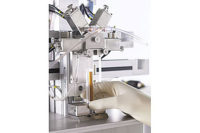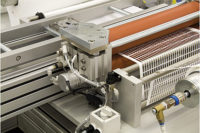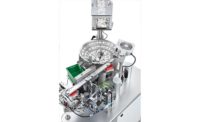Machine vision cameras may be smart, but they won’t be effective unless an engineer is wise enough to properly match them to an application. This statement holds true for any type of manufacturing, especially that involving medical devices.
For example, Eli Lilly and Co. recently installed a high-resolution (5 megapixels) smart camera to inspect subassemblies for one of its medical devices after the standard-resolution camera proved unreliable. Each subassembly consists of two cylinders that are stacked on top of each other and glued together so they share a common centerline.
A large number of subassemblies are placed in a tray that is conveyed to an inspection station. There, a six-axis Mitsubishi robot lifts six subassemblies before placing one at a time in front of a Cognex Corp. In-Sight 5605 smart camera for inspection.
The camera takes a photo of the subassembly and immediately calculates the angle between the centerlines of the two cylinders to determine if it’s within tolerance. According to Eli Lilly engineers, the camera’s high resolution and telecentric lens (made by Edmund Optics) produce distortion-free images, ensuring precise repeatability that generates very few false readings.
A Cognex smart camera also helps a manufacturer of hearing-aid batteries make sure each multipack contains the correct amount of batteries. Incomplete packs are unacceptable to consumers, and the presence of an extra battery could jam the packaging machine when foil backing is applied.
As these two examples illustrate, medical devices are the perfect application for machine vision. The devices must be produced at high volumes (and high speeds) without defects. Equally important, their very small features require a level of consistent and precise inspection that humans just can’t maintain.
Volume Demands Vision
During the 1980s, many medical device manufacturers began automating their assembly processes to keep pace with growing customer demand. The automation equipment included machine vision systems, which were necessary to perform reliable, high-volume inspection of parts and ensure they meet ever-increasing Federal Drug Administration standards.
“At that time, increased production required manufacturers to begin using vision for device inspection, whereas pharmaceutical companies tended to have larger staffs that could handle drug-packaging inspection,” explains Rick Roszkowski, senior director of marketing for the vision products business unit at Cognex Corp. “The initial medical device application for vision, which is still done today, was inspecting needles to make sure they are straight and their ends don’t have any nicks or burrs.”
Fernando Serra, northeast sales manager for Teledyne Dalsa, notes that the typical installation back then involved a frame grabber or low-resolution camera (640 by 480 pixels) that cost at least six figures and had very limited image-collection and image-data-transfer capabilities. Nonetheless, the vision instrument offered more consistency and reliability in high-volume production than the human eye.
The cost of machine vision systems has never been that big of an issue for medical device manufacturers because having lots of people inspect parts is equally, if not more, expensive. Serra says it was not uncommon for some large companies to pay $250,000 for a couple cameras to inspect quarter-size parts in high-volume applications. Even today, it might cost a manufacturer about $45 to inspect a pack of surgical staples. But, this is a worthwhile investment because the pack sells for $800 or more.
Another factor that hasn’t changed over time is how machine vision is used by medical device manufacturers. Between 85 and 90 percent of vision systems are used for inspection and the remainder to help robots or automated equipment perform assembly, says Mark Sippel, project engineer manager for Balluff Inc.
Often the assembly involves electrical components that go into devices such as hearing aids, pacemakers and pumps. This work may or may not be subcontracted to a lower-tier supplier. Vision can also help a robot or machine build tiny electronics, adhere external wiring, or crimp or weld tubing.
So Many Devices
Vision systems do much more than inspect needles and measure staples. Some manufacturers rely on vision to ensure the presence of reagent pads. Others need it to verify placement of suture needles within retainers or confirm the printed gradation on syringe barrels.
At one plant, Eli Lilly uses a color In-Sight vision system to detect fallen vials, identify missing flip-seals and verify cap color on each vial. The system eliminates count-related deviations, resulting in saved money, time and resources that can be allocated elsewhere.
Eli Lilly also uses vision systems in two other inspection applications at other plants. One involves product identification via color inspection. The other focuses on verifying the label material, lot code and expiration date on printed packaging.
Other common medical products requiring inspection include implantable devices (stents, catheters, guide wires) and injection devices, such as insulin pens for diabetics. According to Steve Wong, medical business development manager for Banner Engineering, some manufacturers use vision sensors to verify critical components like syringe caps, plunger rods and plunger position, which indicates a specific dosage amount. He says sensors with an integrated UV light source can also effectively inspect UV-visible adhesive within an assembly.
“One manufacturer assembles a component with an adhesive containing a UV fluorescent agent,” notes Wong. “During inspection, the company uses a sensor with UV lighting to illuminate the adhesive and verify its presence and proper amount.”
Single-use devices, such as surgical forceps and clamping instruments, need to be inspected. Serra says one customer uses vision to inspect a multicomponent, handheld surgical device that, upon squeezing, inserts a clip to close a blood vessel and prevent bleeding. A smart camera provides fast and accurate verification that all components are present before the upper housing is installed to close the device.
Finally, vision systems are used to inspect parts prior to their use in assembly processes. Dennis Shamo, project manager for the technical marketing group at Keyence Corp., says part suppliers often use vision to inspect plastic parts as they come out of a mold to ensure they meet OEM tolerances. The OEMs, in turn, use vision to verify part tolerances after they are delivered to a plant.
Image and Analysis
Through the 1990s, medical device manufacturers relied heavily on frame grabbers and analog cameras for vision inspection. However, their popularity has lessened over the past 15 years as the price of smart cameras has declined and vision sensors have become easier to use.
A frame grabber converts analog images into a digital format and transfers them to a PC. It also captures individual, still frames from a digital video stream. With a multiplexer, the frame grabber can support up to four cameras.
Smart cameras, in comparison, are self-contained. They feature an internal image processor and are more expensive than standard cameras. For these reasons, smart cameras are better suited for single-camera systems; applications where multiple cameras must operate independently or asynchronously; or when vision is needed at multiple inspection points along a production line or within an assembly machine.
Vision sensors also feature multiple components (camera, lighting, imaging sensor, software) in a compact housing. The sensors are able to determine an object’s dimensions, location, shape or orientation. However, they tend to be used for presence-absence applications, whereas smart cameras are capable of much more image analysis or using different types of filters.
Image-processing software is another essential part of any camera- or frame grabber-based vision system. This software focuses on the critical features (measurement, location, geometry, etc.) that determine whether or not a part is within or out of tolerance.
Industrial vision controllers enable manufacturers to quickly set up and easily operate single- or multi-camera systems. Depending on model, a controller can handle up to eight cameras.
A Closer Look
Suppliers have introduced several innovative smart cameras over the past few years. One is the Iris GT, which features an integrated platform that does not need conventional programming.
Applications for this camera include inspecting labels, stents and electronic assemblies in hearing aids, according to Sam Lopez, director of sales and marketing for Matrox Imaging.
Several manufacturers use the camera with Design Assistant, a flowchart-based software that enables the creation of a Web-based operator interface specific to the application. Flowcharts are designed and tested, and the interface is created when the software is not connected to the camera (emulation mode).
With the LumiTrax vision system from Keyence, reflections on cylindrical parts (such as syringes) are removed to ensure accurate inspection, claims Shamo. He says the system has the capability to verify two or more parallel parts and perform optical character recognition (OCR) on plastic packaging.
LumiTrax consists of an ultra-high-speed smart camera, a high-capacity controller and directional lighting (four or eight segments). The lighting enables the camera to capture accurate images of a part’s shape and texture, regardless of part variations or ambient environmental conditions.
VisionPro 3D image-processing software from Cognex works with all smart cameras, as well as Camera Link and analog
frame grabbers. VisionPro and Cognex Vision Library power tools include color sorting and matching, and do not require extensive image preprocessing.
The software’s PatMax algorithm locates parts and features through geometric pattern matching. Real-time 3D position information enables manufacturers to automate challenging assembly verification, robot and logistics applications.
Roszkowski says Cognex also maintains an Acquisition Alliance program with major camera suppliers. Through the program, Cognex supports hundreds of industrial cameras and video formats covering the complete range of acquisition requirements typically used in machine vision.
Although out on the market less than one year, Banner’s iVu Plus Integrated TG Gen2 sensor is used by several manufacturers to inspect syringes, needles and marking or engraving on packaging. Wong says the sensor features a 2.7-inch touch screen on the backside that displays exactly what the sensor sees during inspection.
The touch screen also enables the operator to easily configure an inspection by simply selecting icons on the user menu. Other sensor features include pattern-matching, BLOB, Blemish and sort inspection tools; discrete outputs; Ethernet communication; and adjustable-focus lenses.
BVS-E sensors from Balluff are suitable for a wide range of inspection tasks, according to Sippel. The Universal series simultaneously checks brightness and position, compares contrast, counts edges, detects patterns and reads codes. It also performs accurate 360-degree contour inspection regardless of part location or orientation.
Identification sensors detect and identify bar, 1D and 2D Data Matrix codes, and outputs them via an RS232 serial interface. After each scan, the sensors indicate either OK or an error signal. They come with 8-, 12- or 16-millimeter lenses.
When connected to the GEVA-312T controller, Teledyne’s Genie area scan cameras inspect catheters, surgical needles, syringes and other devices. The controller features a slim-line design, a 12-inch touch screen, a 1.6-gigahertz dual-core processor and two GigE camera ports.
A standard GigE switch is required for applications requiring three or more cameras. Input-output connections, including camera trigger and light strobes, are interfaced with a PL-USB module. The front of the unit features push buttons for display adjustments and a USB port for a keyboard, mouse or data transfer.
Panasonic’s PV-200 and PV-230 controllers are flexible enough to handle color and grayscale cameras offering various resolutions. Erwin Wu, director of the industrial automation division for Panasonic Industrial Devices Co. of America, says color cameras have resolutions of 0.3 megapixel (standard or compact) or 2 megapixels. Grayscale cameras are also available with a 4- megapixel resolution.
Integrated image-processing software in both models detects up to 3,000 edge points for a line and 3,600 for a circle. The PV-230 also has OCR and OCV capabilities for code inspection.
“A good vision system guarantees quality control,” concludes Lopez. “Because, unlike a person, it always stays focused and is never bored.”







